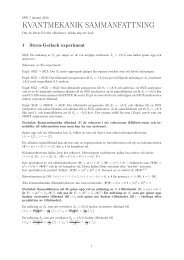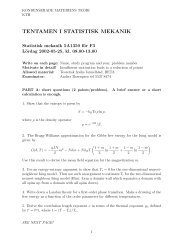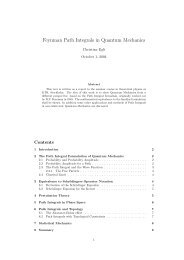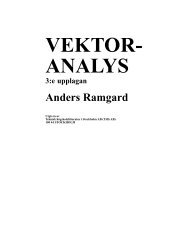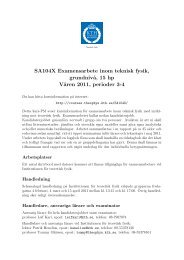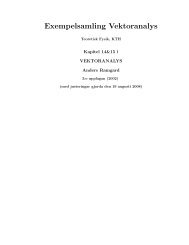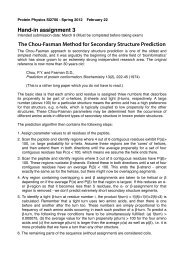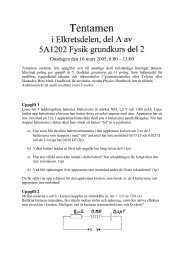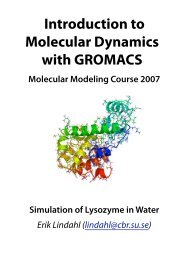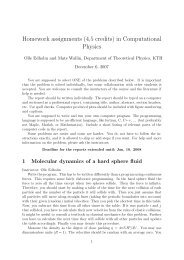[VAR]=Notes on variational calculus
[VAR]=Notes on variational calculus
[VAR]=Notes on variational calculus
Create successful ePaper yourself
Turn your PDF publications into a flip-book with our unique Google optimized e-Paper software.
Boundary c<strong>on</strong>diti<strong>on</strong>s. Above we c<strong>on</strong>sidered a variati<strong>on</strong>al problem where the allowed<br />
functi<strong>on</strong>s were fixed at the end points. There are other such problems where this is not<br />
the case, and then <strong>on</strong>e also gets Euler-Lagrange equati<strong>on</strong>s but with different boundary<br />
c<strong>on</strong>diti<strong>on</strong>s. The derivati<strong>on</strong> of the Euler-Lagrange equati<strong>on</strong>s above is important since<br />
it also shows how the correct boundary c<strong>on</strong>diti<strong>on</strong>s are. To show that I c<strong>on</strong>sider the<br />
derivati<strong>on</strong> of the following variant of Fact A above:<br />
Fact B: All functi<strong>on</strong>s u(x) extremizing the functi<strong>on</strong>al J[u] in (7) (without any c<strong>on</strong>straints<br />
at the end points!) are soluti<strong>on</strong>s of the Euler-Lagrange equati<strong>on</strong>s in (8) with<br />
the boundary c<strong>on</strong>diti<strong>on</strong>s<br />
∂F<br />
∂F<br />
∂u ′ (x) ∣ = 0,<br />
x=x0<br />
∂u ′ (x) ∣ = 0. (12)<br />
x=x1<br />
This is easy to understand from the computati<strong>on</strong> in (11): the boundary term in<br />
the last line now no l<strong>on</strong>ger vanishes automatically (since η(x 0 ) and η(x 1 ) can now be<br />
arbitrary), and to have it zero we have to require (12). Of course, <strong>on</strong>e could also have<br />
a variati<strong>on</strong>al problem where η(x 0 ) is fixed but η(x 1 ) is arbitrary - in this case we <strong>on</strong>ly<br />
get the sec<strong>on</strong>d c<strong>on</strong>diti<strong>on</strong> in (12), etc.<br />
Remark <strong>on</strong> how to solve such Euler-Lagrange equati<strong>on</strong>s: In general, the Euler-<br />
Lagrange equati<strong>on</strong> in (8) is a ODE of order 2 (since ∂F/∂u ′ (x) typically c<strong>on</strong>tains some<br />
power of u ′ (x), which, when differentiated, gives a term u ′′ (x)). The general soluti<strong>on</strong><br />
of this equati<strong>on</strong> thus c<strong>on</strong>tains two arbitrary c<strong>on</strong>stant which need to be fixed by two<br />
c<strong>on</strong>diti<strong>on</strong>s: either the c<strong>on</strong>diti<strong>on</strong>s in Fact A above, or otherwise the c<strong>on</strong>diti<strong>on</strong>s in Fact<br />
B.<br />
Anyway, solving a 2nd order ODE is not always easy, and there are two important<br />
special cases where the problem can be simplified to a 1st order ODE:<br />
Fact C: (a) For a functi<strong>on</strong> F = F(u ′ (x), x) independent of u(x), the Euler-Lagrange<br />
equati<strong>on</strong>s in (8) are equivalent to<br />
for an arbitrary integrati<strong>on</strong> c<strong>on</strong>stant C.<br />
∂F<br />
∂u ′ (x) = C (13)<br />
(b) For a functi<strong>on</strong> F = F(u(x), u(x)) independent of x, the Euler-Lagrange equati<strong>on</strong>s<br />
in (8) are implied by<br />
u ′ ∂F<br />
(x)<br />
∂u ′ (x) − F = C (14)<br />
for an arbitrary integrati<strong>on</strong> c<strong>on</strong>stant C.<br />
8


![[VAR]=Notes on variational calculus](https://img.yumpu.com/35639168/8/500x640/varnotes-on-variational-calculus.jpg)
